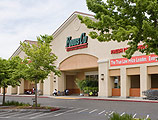Retail has the virus. Just as with people, different retailers are reacting to this infection very differently. Ailing merchants with comorbidities are suffering — or dying — while those without long-term illnesses are asymptomatic, even healthy.
Excess capacity — too many stores — has been American retail’s primary chronic condition for decades. In 2017, Forbes noted, “Since 1995, the number of shopping centers in the U.S. has grown by more than 23% and the total gross leasable area by almost 30%, while the population has grown by less than 14%.” According to Forbes, America has roughly 50 square feet of retail space per capita while Europe has just 2.5 square feet. We have too many retailers selling the same — let’s call it stuff — in every city in the country.
Where are we today? First, those retailers that you thought died years ago — notably, Sears, J.C. Penney and Kmart — will finally give up the ghost. Then, others with bad management or too much debt or overwhelming competition will also disappear.
As a result, every city in the country will be confronted with dying malls and vacancy-pocked shopping districts. As this recession grinds on over the next several years, retail’s pulse will falter. Is there a cure? No. The failing retailers were already on their way to the morgue; the virus merely hastened their demise. Is there a vaccine that will help? Yes, and not to flog the medical metaphor, but there is a cocktail of civic remedies that, if implemented, would help stabilize retail.
“First, do no harm” is a catchy medical phrase that should serve as a shibboleth for planners and city councils. In this context it means stop zoning more retail. The last thing struggling merchants need is more competition. And, given the headwinds, it would be optimistic to assume that retail will return any time soon, if ever, to even a zero-sum game (that is, vacancies offset by new tenants). Cities zoning more retail are in danger of creating instant blight, storefronts that will never fill. To get healthy, retail needs to shrink to a sustainable size — somewhere between us and Europe’s size zero — then stabilize.
In particular, trendy cities must abandon their mixed-use fantasies. Too much bad retail — space that will never lease — has already been constructed by reluctant office and apartment developers. Why? They were forced to by starry-eyed urban planners dreaming of turning their towns into Manhattan’s west side. For retail to have a fighting chance, it needs three things: great access, visibility and traffic (whether vehicular or pedestrian). Few mixed-use projects offer even one of these prerequisites.
“Second, loosen up the zoning” isn’t as catchy as do no harm, but it’s as important. Traditional retail zoning requires that a merchant actually sells stuff, hard goods like books or soft like clothing. Cities need to face the reality that those are the types of businesses on the double-secret endangered list, the uses most vulnerable to e-commerce; once they go, they’re gone. Mandating only “true retailers” in a shopping district is like building a bird house for passenger pigeons. Won’t matter how pretty it is, they’re still extinct.
How do you loosen up the zoning? Easy: First you shrink the retail districts themselves, then you allow in any business that has a customer, a patient, a client, a student, or any sort of visitor at all. You drop your prohibition against banks and financial services, you permit dentists, travel agents, gyms, yoga studios, doctors — even lawyers and palm readers — every personal service imaginable to occupy those otherwise unfillable retail storefronts.
Also, if you truly wish to help your retail districts, you drop the prohibitions against chain stores. Every chain store in America started as a single store. Prohibiting chains is simply redlining success in the hope of keeping a given neighborhood unique. If you wish to have a not-so-unique collection of empty storefronts, you maintain the prohibition against stores at which people actually want to shop.
“Third, cut the regulations” is less catchy still, but the fancy cities should take a page from the provincial towns that go all-out to spark development. A few years ago, we approached a small town on Interstate 5 about a supermarket we wanted to build. “When can you break ground?” was the city manager’s only question. And, true to his word, the town approved our plans as fast as we could submit them. National retailers have choices about where to locate, where to expend their efforts. Often, a given city is no more appealing than 20 others. And retailers have feelings (most of them, anyway); they want to go where they feel welcomed. Hence, the great appeal of Texas.
There is no panacea, but with effort and more understanding on the part of cities, retail need not circle the drain.






















